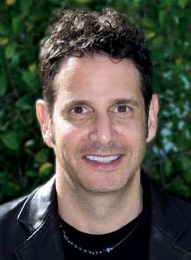|
|
|
ALUMNI UPDATES
The Mind and Body of Douglas Sadownick ’81
By Justin Clark ’04J


Douglas Sadownick ’81 has founded the country’s first LGBT specialization in clinical psychology, at Antioch College in L.A.
PHOTO: ROGER KAUFMAN

Drop into one of Douglas Sadownick ’81’s clinical psychology classes at Antioch College in Los Angeles, and you may conclude you’re in the wrong building. Instead of a droning lecture on Freudian theory, you’ll find students beginning class by dancing to the records of early-’80s disco artists.
“Most instructors would come into the classroom and put a few words on the board,” explains fellow Antioch professor Roger Kaufman bemusedly. “Doug comes into the classroom and puts on some Gloria Gaynor.”
Gloria Gaynor and Carl Jung may sound like strange bedfellows, says Kaufman, who teaches in the ground-breaking program Sadownick founded last year at Antioch, the country’s first Lesbian-Gay-Bisexual- Transsexual (LGBT) specialization in clinical psychology. But that’s only because psychology isn’t all in the head, says Kaufman, especially for gays, who as a result of internalized self-prejudice often feel alienated from their bodies.
“There’s a very serious point about getting people to feel their bodies,” explains Kaufman. “Doug has struggled because he is a thinking type, and so it’s been a struggle for him to get more into his body. But he’s embraced that with so much gusto, and he’s bringing that to his students.”
In addition to taking the regular courses required to become marriage and family therapists, students in the specialization must complete a 17-unit program that includes such courses as “LGBT Adolescent and Youth Identity Issues” and “Models of LGBT Self-Esteem.”
Courses like these have long been missing from the education of therapists, says Thomas Young, an LGBT therapy expert active with the Lesbian and Gay Psychotherapy Association. “The program is vital, since it teaches things many therapists only learn later in clinical practice,” says Young. “For example, the therapist needs to be aware of the pressures of being in a same-sex relationship when there isn’t outside affirmation from society, and to recognize the depressive issues associated with coming out.”
Sadownick echoes the point. “There’s very poor training for therapists working with the LGBT community,” he says, explaining that it’s not enough to avoid pathologizing homosexuality, as psychologists once did. A neutral manner of interaction traditionally has allowed even LGBT therapists to avoid their own internalized homophobia, says Sadownick. The solution is to replace an atmosphere of LGBT “acceptance” with one of active celebration.
That process of self-confrontation began in the late ’70s for Sadownick, who didn’t visit Columbia until after his acceptance, even after spending his childhood in the Bronx. The product of a family that rejected homosexuality, Sadownick was intensely shy, bookish and closeted when he arrived at Columbia. Almost immediately he joined the Gay Student Union, however, and began to find himself.
“I came out with a bang, and became a completely different person,” he says.
The first dance Sadownick attended was put on by the Gay Student Union at a Columbia residence hall, and he recalls that the event made him feel as if he were living in his body for the first time. Soon he was hanging out with Allen Ginsberg ’48 in Morningside Heights, and heading down to gay bars in the East Village such as the Ninth Circle.
“I remember going out and looking at the sky and the stars and feeling like life was beautiful for the first time,” he says, still sounding moved by the experience.
But, says Sadownick, he was unable to reconcile his newfound his identity as a gay man with the intellectual aspirations that had originally brought him to Columbia. He was never able to talk to Ginsberg about gay liberation, for instance, simply because he met the famed poet within the world of the University, instead of the more openly gay atmosphere of the East Village.
In the end, it was a relationship that caused Sadownick to change his professional course.
“I was going to be an English professor and I was going to write books on English literature, but then I got involved in a 14-year relationship with a performance artist named Tim Miller, who was one of the ‘NEA Four,’” says Sadownick, referring to a group of controversial artists whose NEA grants were vetoed by Congress in the early 1990s. “Tim said, ‘You’ve got to live in your body.’”
For Sadownick, that meant dropping out of his English Ph.D. program at NYU and becoming an AIDS activist, a gay-issues journalist and later a novelist. Sadownick’s Sacred Lips of the Bronx was nominated for a Lambda, gay fiction’s most prestigious award, in 1994. Sadownick followed Miller to Los Angeles, where after beginning therapy under a gay-centered analyst, he realized there might be a place for him in academia after all.
After getting his Ph.D. in clinical psychology at Pacifica Institute last year, Sadownick founded his unique specialization at Antioch. He describes himself as a happy single man and “a recent extrovert.” It has been a decade since his last visit to New York, but he believes the years have been as positive and transformative for his alma mater as they have been for him.
“I was never able to combine my studies with being gay, and that was a loss,” he says. “But what students have today at Columbia and elsewhere — leaders who are gay-identified — is absolutely wonderful.”
Justin Clark ’04J lives in Los Angeles and contributes to LA Weekly, Plenty and Nerve.com
|
|
|




